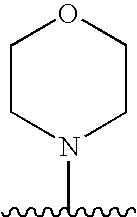Formulations for pharmaceutical agents ionizable as free acids or free bases
a technology of free acids and pharmaceutical agents, applied in the field of formulations of compounds, can solve the problems of low oral bioavailability and aqueous solubility, and achieve the effects of reducing the number of forms
- Summary
- Abstract
- Description
- Claims
- Application Information
AI Technical Summary
Benefits of technology
Problems solved by technology
Method used
Image
Examples
synthesis examples
The compounds of this invention, as well as the precursor 2-oxindoles and aldehydes, may be readily synthesized using techniques well known in the chemical arts. It will be appreciated by those skilled in the art that other synthetic pathways for forming the compounds of the invention are available and that the following is offered by way of example and not limitation.
A. General synthetic procedure.
The following general methodology may be employed to prepare the compounds of this invention:
The appropriately substituted 2-oxindole (1 equiv.), the appropriately substituted aldehyde (1.1 equiv.) and a base (0.1 equiv.) are mixed in a solvent (1-2 ml / mmol 2-oxindole) and the mixture is then heated for from about 2 to about 12 hours. After cooling, the precipitate that forms is filtered, washed with cold ethanol or ether and vacuum dried to give the solid product. If no precipitate forms, the reaction mixture is concentrated and the residue is triturated with dichloromethane / ether, the r...
example 1 (from table 1)
4-Methyl-5-(2-oxo-1,2-dihydroindol-3-ylidenemethyl)-1H-pyrrole-2-carboxylic Acid
4-Methyl-2-pyrrolecarboxylic acid ethyl ester (commercially available) was formylated using method A to give (73%) of 5-formyl-4-methyl-2-pyrrolecarboxylic acid ethyl ester. It was then hydrolysed using method B to give 5-formyl-4-methyl-1H-pyrrole-2-carboxylic acid (58%).
Oxindole (133 mg, 1 mmol) was condensed with 5-formyl-4-methyl-1H-pyrrole-2-carboxylic acid (153 mg) using method D to give 268 mg (100%) of the title compound as an orange-red solid.
1HNMR (360 MHz, DMSO-d6) δ 13.84 (s, br, 1H, NH), 12.84 (s, br, 1H, COOH), 10.98 (s, br, 1H, NH), 7.82 (d, J=7.5 Hz, 1H), 7.67 (s, 1H, H-vinyl), 7.18 (t, J=7.5 Hz, 1H), 7.01 (t, J=7.5 Hz, 1H), 6.88 (d, J=7.5 Hz, 1H), 6.71 (d, J=2.2 Hz, 1H), 2.32 (s, 3H, CH3).
MS (negative mode) 266.8 [M−1]+.
example 2 (from table 1)
4-Methyl-5-(1-methyl-2-oxo-1,2-dihydroindol-3-ylidenemethyl)-1H-pyrrole-2-carboxylic Acid
1-Methyl-1,3-dihydroindol-2-one (147 mg, 1 mmol) was condensed with 5-formyl-4-methyl-1H-pyrrole-2-carboxylic acid (153 mg) using method D to give 250 mg (86%) of the title compound.
1HNMR (360 MHz, DMSO-d6) δ 13.82 (s, br, 1H, NH), 12.88 (s, br, 1H, 7.83 (d, J=7.5 Hz, 1H), 7.65 (s, 1H, H-vinyl), 7.26 (t, J=7.5 Hz, 1H), 7.02-7.09 (m, 2H), 6.70 (d, J=2.2 Hz, 1H), 2.32 (s, 3H, CH3).
MS m / z 283.0 [M+1]+.
PUM
| Property | Measurement | Unit |
|---|---|---|
| Mass | aaaaa | aaaaa |
| Mass | aaaaa | aaaaa |
| Mass | aaaaa | aaaaa |
Abstract
Description
Claims
Application Information
 Login to View More
Login to View More - R&D
- Intellectual Property
- Life Sciences
- Materials
- Tech Scout
- Unparalleled Data Quality
- Higher Quality Content
- 60% Fewer Hallucinations
Browse by: Latest US Patents, China's latest patents, Technical Efficacy Thesaurus, Application Domain, Technology Topic, Popular Technical Reports.
© 2025 PatSnap. All rights reserved.Legal|Privacy policy|Modern Slavery Act Transparency Statement|Sitemap|About US| Contact US: help@patsnap.com



